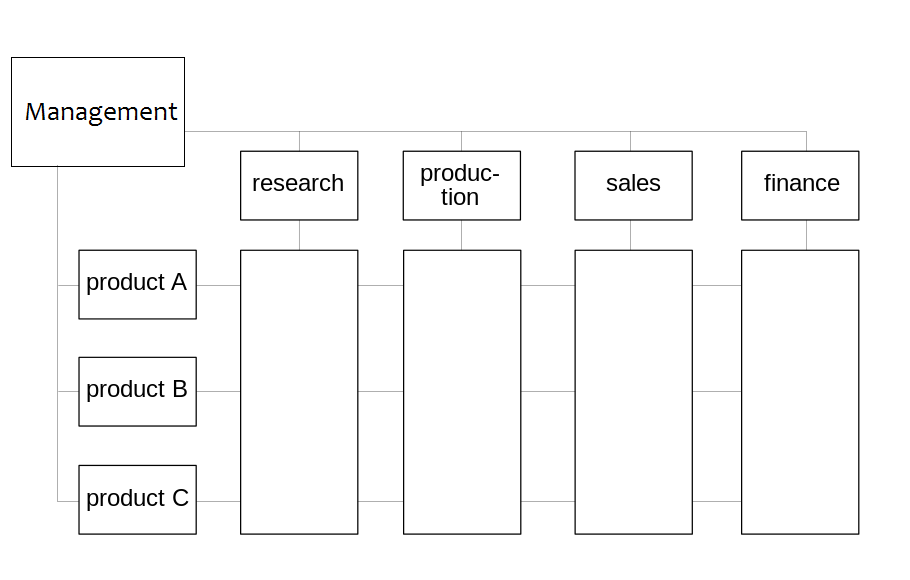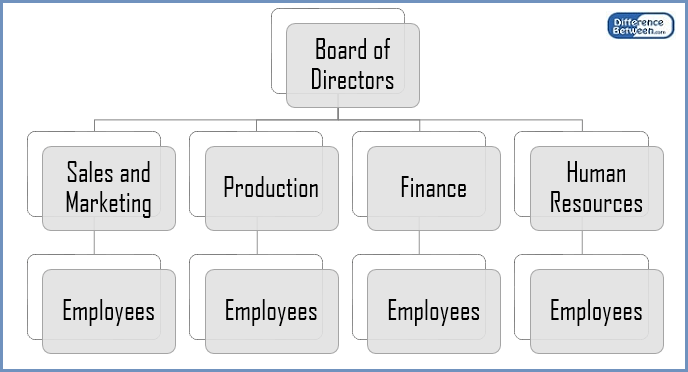Difference Between Matrix and Functional Structure
Table of Contents
Key Difference – Matrix vs Functional Structure
An organization can be arranged according to a variety of structures, which enable the organization to operate and perform. Its objective is to carry out operations smoothly and efficiently. The key difference between matrix structure and functional structure is that matrix structure is a type of organizational structure where employees are grouped concurrently by two different operational dimensions whereas functional structure is a structure that divides the organization based on specialized functional areas such as production, marketing, and sales for the purpose of management.
CONTENTS
1. Overview and Key Difference
2. What is Matrix Structure
3. What is Functional Structure
4. Side by Side Comparison – Matrix vs Functional Structure
5. Summary
What is Matrix Structure?
The matrix structure is a type of organizational structure where employees are grouped concurrently by two different operational dimensions. This means that a matrix structure combines two organizational structures, most commonly a functional structure and a divisional structure. By nature, the matrix structure is inherently complex and costly to implement making them appropriate for large scale organizations that generally undertake various projects.
E.g. OPQ is a multinational company that produces technology based products. It has a Research and Development (R&D) function where the employees report to an R&D manager. OPQ decided to undertake a project with another company which will require some of the employees to report to a project manager in addition to the R&D manager.
Skills are better utilized under a matrix structure and the company can select the most capable employees in order to deliver projects. A company that operates in various regions with different products that require interaction between functions and projects can significantly benefit from using a matrix structure. Further, matrix structures can be used to serve global customers by integrating business functions and responding to customer demands fast. However managing a matrix structure is complicated and challenging. This type of organizational structure leads to dual responsibility where the employees are answerable to both the functional manager and project manager, creating a higher manager-to-worker ratio. This may sometimes lead to conflicts when prioritization of work is considered.

Function 1: Matrix structure is organized by combining two organizational structures
What is Functional Structure?
A functional structure is a commonly used organizational structure in which the organization is divided into smaller groups based on specialized functional areas such as production, marketing, and sales. Each function is managed by a departmental head that has a dual responsibility to be accountable to the top management and to direct the respective department to achieve favorable performance. Such functional areas are also referred to as ‘silos’.
Functional structures are ‘U-form’ (Unitary form) organizational structures where the operations are categorized based on common expertise and experience. The functions such as finance and marketing are shared across divisions or products. The most significant advantage of this type of a structure is that the company will be able to benefit from specialized functional expertise and enjoy notable cost savings by using shared services.
E.g. JKL Company operates with a divisional structure and produces 5 product categories. All these categories are produced by an SDH’s production team and marketed by a sole marketing team.
However, functional structures are difficult to adopt for larger scale companies that operate in a wide geographical area, especially if the organization has overseas operations. In the above example, assume that 2 out of the 5 product categories are sold in two different countries. In that case, the products have to be shipped to the respective countries, and different marketing approach may have to be used. Managing overseas business being in the home country is difficult and less successful.

Figure 1: Functional structure
What is the difference between Matrix and Functional Organization?
Matrix vs Functional Organization | |
| Matrix structure is a type of organizational structure where employees are grouped concurrently by two different operational dimensions. | Functional structure divides the organization based on specialized functional areas such as production, marketing, and sales for the purpose of management. |
| Complexity | |
| Matrix structure is complex in nature due to the combination of two organizational structures | Functional structure is simple and convenient to manage. |
| Appropriateness | |
| Matrix structure is appropriate for companies that have multiple product categories and carries out various projects | Functional structure is suitable for organizations that operate in a single location with a single product category. |
Summary – Matrix vs Functional Structure
The difference between matrix structure and functional structure mainly depends on the way they are structured and managed. For organizations that are significant in scale with many product groups, a matrix structure is ideal for management purpose. If the organization is small or medium scale and has less diverse operations, then adopting a functional structure is appropriate. Proper chain of command and effective allocation of resources lead to higher employee motivation and cost savings. Thus the selection of organization structure should be made with care.
References:
1. “Functional Structure – Boundless Open Textbook.” Boundless, 31 May 2016. Web. 04 Apr. 2017.
2. “Functional Structure of an Organization: Advantages, Disadvantages & Example – Video & Lesson Transcript.” Study.com. N.p., n.d. Web. 06 Apr. 2017.
3. “Matrix Structure – Boundless Open Textbook.” Boundless, 31 May 2016. Web. 06 Apr. 2017.
4. “Disadvantages of Organizations with the Matrix Approach.” Chron.com. 08 Sept. 2011. Web. 06 Apr. 2017.
Image Courtesy:
1. “Matrix organisation scheme” By Chery – Own work (Public Domain) via Commons Wikimedia
ncG1vNJzZmivp6x7pbXFn5yrnZ6YsqOx07CcnqZemLyue8OinZ%2Bdopq7pLGMm5ytr5Wau265wK2porBdlruledWsZJ%2BtnpjBqrvNmqNmq6SnwqTA1KucaA%3D%3D